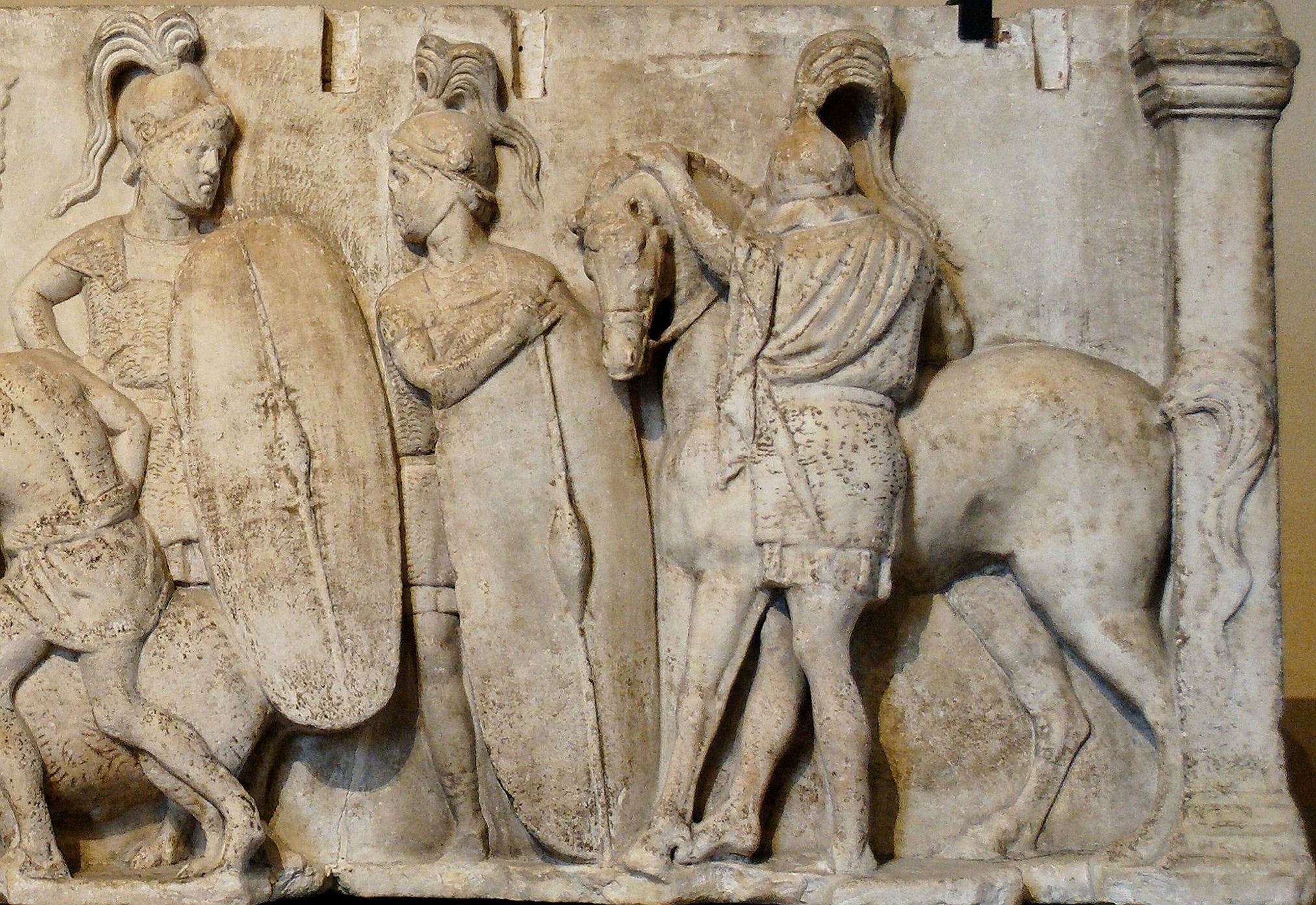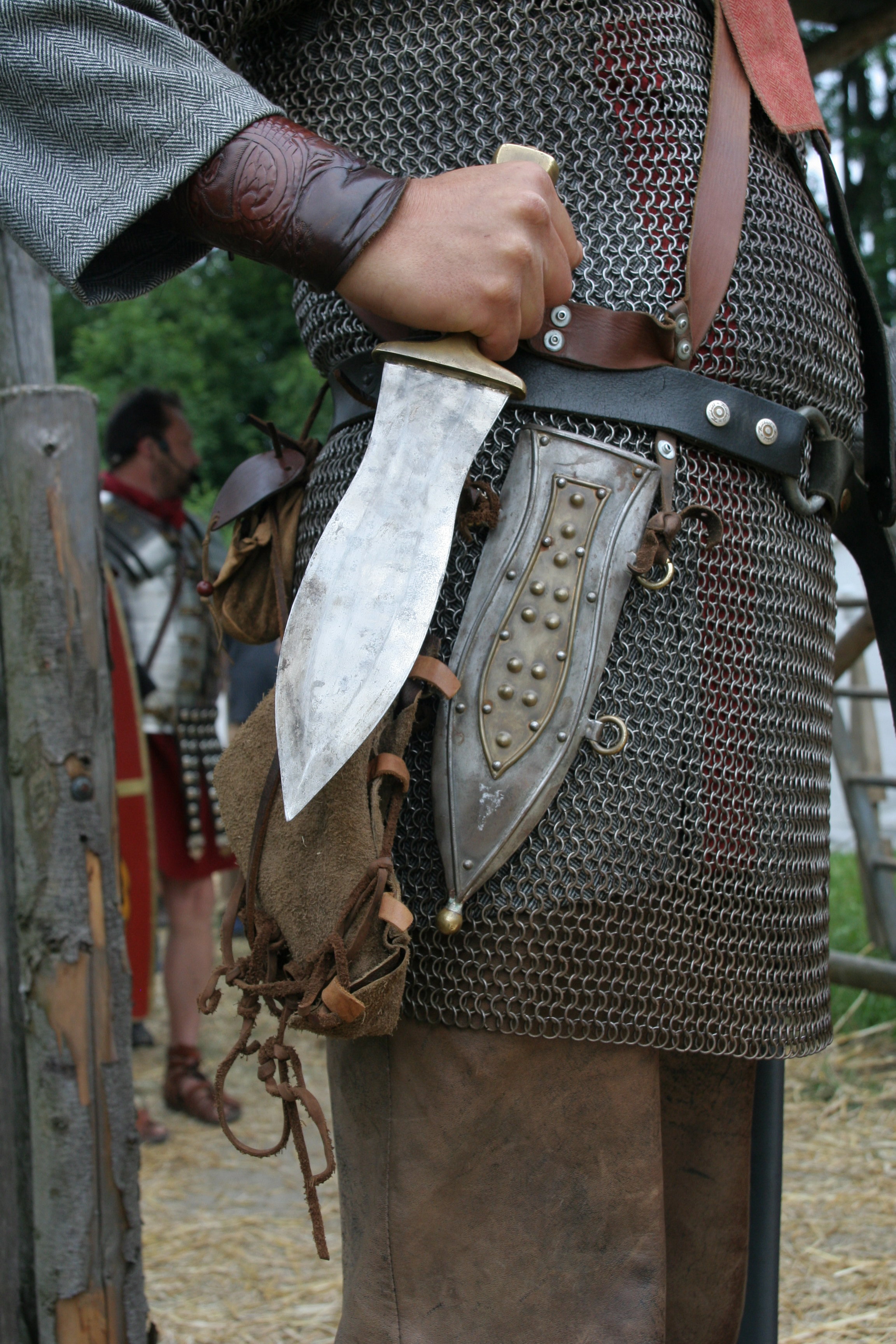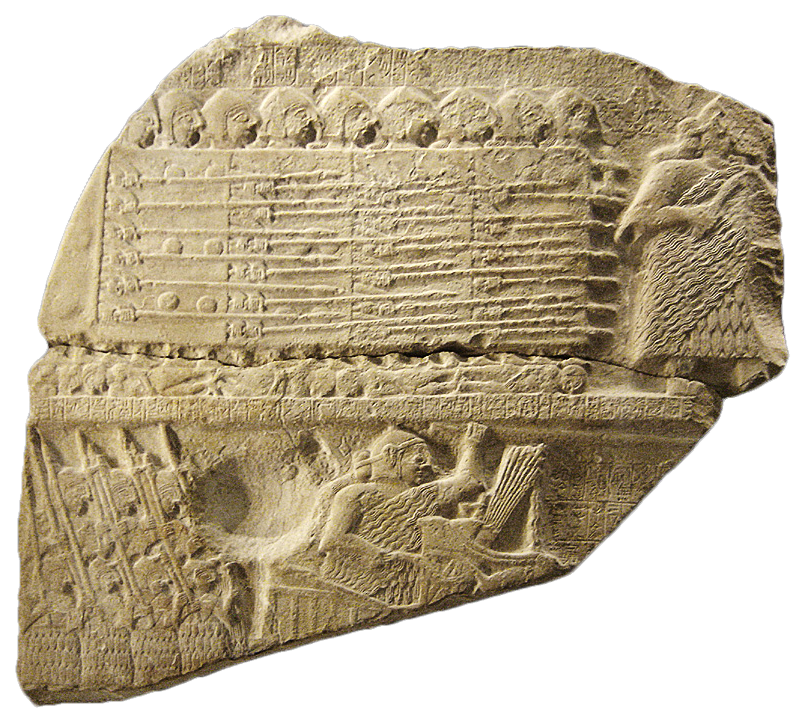|
Hastati
''Hastati'' (: ''hastatus'') were a class of infantry employed in the Structural history of the Roman military#Manipular legion (315 BC – 107 BC), armies of the early Roman Republic, who originally fought as spearmen and later as swordsmen. These soldiers were the staple unit after Rome threw off Etruscan civilization, Etruscan rule. They were originally some of the poorest men in the legion, and could afford only modest Roman military personal equipment, equipment—light chainmail and other miscellaneous equipment. The Senate supplied their soldiers with only a short stabbing sword, the gladius, and their distinctive squared shield, the Scutum (shield), scutum. The ''hastatus'' was typically equipped with these, and one or two soft iron tipped throwing spears called Pilum, pila. This doubled their effectiveness, not only as a strong leading edge to their Maniple (military unit), maniple, but also as a stand-alone missile troop. Later, the ''hastati'' contained the younger men ... [...More Info...] [...Related Items...] OR: [Wikipedia] [Google] [Baidu] |
Triarii
''Triarii'' (: ''triarius'') ("the third liners") were one of the elements of the early Roman military manipular legions of the early Roman Republic (509 BC – 107 BC). They were the oldest and among the wealthiest men in the army and could afford high quality equipment. They wore heavy metal armor and carried large shields, their usual position being the third battle line. They were equipped with spears and were considered to be elite soldiers among the legion. During the Camillan era, they fought in a shallow phalanx formation, supported by light troops. In most battles ''triarii'' were not used because the lighter troops usually defeated the enemy before the ''triarii'' were committed to the battle. They were meant to be used as a decisive force in the battle, thus prompting an old Roman saying: ''res ad triarios venit'', 'it comes down to the triarii', which meant carrying on to the bitter end. History and deployment According to author Pat Southern, ''triarii'' may ha ... [...More Info...] [...Related Items...] OR: [Wikipedia] [Google] [Baidu] |
Roman Infantry Tactics
Roman infantry tactics are the theoretical and historical deployment, formation, and manoeuvres of the Roman infantry from the start of the Roman Republic to the fall of the Western Roman Empire. The original Roman army was made up of ''hoplite, hoplites'', whose main strategy was forming into a ''phalanx''. By the early third century BCE, the Roman army would switch to the Maniple (military unit), maniple system, which would divide the Roman army into three units, ''hastati'', ''principes'', and ''triarii''. Later, in 107BCE, Gaius Marius, Marius would institute the so-called Marian reforms, creating the Roman legions. This system would evolve into the Late Roman army, Late Roman Army, which utilized the ''comitatenses'' and ''limitanei'' units to defend the Roman Empire, Empire. Roman legionaries had armour, a ''gladius'', a shield, two ''Pilum, pila'', and Rationing, food rations. They carried around tools such as a ''dolabra'', a wooden Stave (wood), stave, and a shallow wicke ... [...More Info...] [...Related Items...] OR: [Wikipedia] [Google] [Baidu] |
Principes
''Principes'' (: ''princeps'') were Spear, spearmen, and later Swordsmanship, swordsmen, in the Roman army of the mid-Republic, armies of the early Roman Republic. They were men in the prime of their lives who were fairly wealthy, and could afford decent equipment. They were the heavy infantry, heavier infantry of the Roman legion, legion who carried large shields and wore good quality armor. Their usual position was the second battle line. They fought in a Roman infantry tactics#Layout of the triple line, quincunx formation, supported by light troops. They were eventually disbanded after the so-called "Marian reforms" of the late Roman Republic. History and deployment According to Pat Southern, ''principes'' appear to have been born from remnants of the old second class of the army under the Kings of Rome, Etruscan kings when it was reformed by Marcus Furius Camillus. The second class stood in some of the first few ranks of a very large Phalanx formation, phalanx and were equip ... [...More Info...] [...Related Items...] OR: [Wikipedia] [Google] [Baidu] |
Structural History Of The Roman Military
The structural history of the Roman military concerns the major transformations in the organization and constitution of ancient Rome's armed forces, "the most effective and long-lived military institution known to history."''Encyclopædia Britannica'', Eleventh Edition (1911), ''The Roman Army'' At the highest level of structure, the forces were split into the Roman army and the Roman navy, although these two branches were less distinct than in many modern national defense forces. Within the top levels of both army and navy, structural changes occurred as a result of both positive military reform and organic structural evolution. These changes can be divided into four distinct phases. ;Phase I: The army was derived from obligatory annual military service levied on the citizenry, as part of their duty to the state. During this period, the Roman army would wage seasonal campaigns against largely local adversaries. ;Phase II: As the extent of the territories falling under Roman ... [...More Info...] [...Related Items...] OR: [Wikipedia] [Google] [Baidu] |
Maniple (military Unit)
Maniple (; ) was a tactical unit of the Roman Republican armies, adopted during the Samnite Wars (343–290 BC). It was also the name of the military insignia carried by such units. Maniple members, called ''commanipulares'' (: ''commanipularis'') were seen as each other's brothers-in-arms, but without the domestic closeness of the eight-man '' contubernium''. Cohorts replaced maniples as organisational units. History The manipular system was adopted around 315 BC, during the Second Samnite War. The rugged terrain of Samnium, where the war was fought, was not conducive to the phalanx formation which the Romans had inherited from the Etruscans and Ancient Greeks. The main battle troops of the Etruscans and Latins of this period comprised Greek-style hoplite phalanxes, inherited from the original Greek phalanx military unit. After suffering a series of defeats, culminating in the surrender of the entire army without resistance at Caudine Forks, the Romans abandoned the ph ... [...More Info...] [...Related Items...] OR: [Wikipedia] [Google] [Baidu] |
Accensi
The term ''accensi'' (: ''accensus'') is applied to two different groups. Originally, the ''accensi'' were light infantry in the armies of the early Roman Republic. They were the poorest men in the legion, and could not afford much equipment. They did not wear armour or carry shields, and their usual position was part of the third battle line. They fought in a loose formation, supporting the heavier troops. They were eventually phased out by the time of Second Punic War. In the later Roman Republic the term was used for civil servants who assisted the elected magistrates, particularly in the courts, where they acted as ushers and clerks. Infantry History and deployment ''Accensi'' appear to have evolved from the old fifth class of the army under the Etruscan kings when it was reformed by Marcus Furius Camillus. The fifth class was made up of the poorest soldiers in the legion who were equipped with slings and perhaps a small shield. They acted as skirmishers, screening the ... [...More Info...] [...Related Items...] OR: [Wikipedia] [Google] [Baidu] |
Leves
''Leves'' (: ''levis'') were javelin-armed skirmishers in the army of the early Roman Republic. They were typically some of the youngest and poorest men in the legion, and could not afford much equipment. They were usually outfitted with just a number of light javelins and no other equipment. There were 300 leves in a legion, and unlike other infantry types they did not form their own units, but were assigned to units of ''hastati'' – heavier sword-armed troops. Their primary purpose on the battlefield was to harass the enemy with javelin fire and support the heavy infantry who fought in hand-to-hand combat. '' Accensi'' and '' rorarii'' were also light missile troops and had similar roles. History and deployment ''Leves'' appear to have evolved from the old poor classes of the army under the Etruscan kings when it was reformed by Marcus Furius Camillus ca. 386 BC. These soldiers stood at the rear of a very large phalanx and were equipped in a similar manner to ''leves' ... [...More Info...] [...Related Items...] OR: [Wikipedia] [Google] [Baidu] |
Roman Military Personal Equipment
Roman military personal equipment was produced in large numbers to established patterns, and used in an established manner. These standard patterns and uses were called the ''res militaris'' or ''disciplina''. Its regular practice during the Roman Republic and Roman Empire led to military excellence and victory. The equipment gave the Romans a very distinct advantage over their "barbarian" enemies, especially so in the case of armour. This does not mean that every Roman soldier had better equipment than the richer men among his opponents. Roman equipment was not of a better quality than that used by the majority of Rome's adversaries. Other historians and writers have stated that the Roman army's need for large quantities of "mass produced" equipment after the so-called "Marian Reforms" and subsequent civil wars led to a decline in the quality of Roman equipment compared to the earlier Republican era: Initially, they used weapons based on Greek and Etruscan models. On encou ... [...More Info...] [...Related Items...] OR: [Wikipedia] [Google] [Baidu] |
Hasta (spear)
The ''hasta'' (: ''hastae'') was the spear carried by early Roman legionaries, for which the Roman soldiers known as ''hastati'' were named. In later Roman Republic, republican times, the ''hastati'' were re-armed with ''pilum, pila'' and ''gladius, gladii'', and the ''hasta'' was only retained by the ''triarii''. The ''hasta'' would also be reintroduced in the Late Roman army in conjunction with the spatha. Unlike the ''pilum,'' ''verutum'' and ''lancea (weapon), lancea'', the ''hasta'' was not thrown, but used for thrusting. It was about in length, with a shaft generally made from Fraxinus, ash, while the head was of iron. ''Hasta'' also referred to a spear that was a gymnastic weapon. The ''hasta prapilata'' was a spear with its point either covered by a ball or muffled. This type of spear was used by soldiers during training. ''Hasta pura'' The ''hasta pura'' was a spear used in the Roman army as a Military awards and decorations, military decoration for a soldier tha ... [...More Info...] [...Related Items...] OR: [Wikipedia] [Google] [Baidu] |
Rorarii
''Rorarii'' were soldiers who formed the final lines, or else provided a reserve thereby, in the ancient pre- Marian Roman army. They may have been used with the ''triarii'' in battle near the final stages of fighting, since they are recorded as being located at the rear of the main battle formation. They may have been similar in role to the ''accensi'', acting as supernumeraries and filling the places of fallen soldiers as a battle or campaign wore on. Alternatively, they may have been skirmishers akin to ''velites'' as stated by Livy in Book VIII.8. Unfortunately, the evidence is so limited that it is difficult to understand what direct role the ''rorarii'' may have had, if any, in fighting. It seems most likely that they were not part of the line in the same way as ''triarii'', ''principes'' and ''hastati'' were. They may also have been the light equivalent of the ''triarii'', just like the ''accensi'' would have been the light equivalent of the ''principes'', both ''rorarii'' ... [...More Info...] [...Related Items...] OR: [Wikipedia] [Google] [Baidu] |
Punic Wars
The Punic Wars were a series of wars fought between the Roman Republic and the Ancient Carthage, Carthaginian Empire during the period 264 to 146BC. Three such wars took place, involving a total of forty-three years of warfare on both land and sea across the western Mediterranean region, and a four-year-long Mercenary War, revolt against Carthage. The First Punic War broke out on the Mediterranean island of Sicily in 264BC as a result of Rome's expansionary attitude combined with Carthage's proprietary approach to the island. At the start of the war Carthage was the dominant power of the western Mediterranean, with an extensive maritime empire (a thalassocracy), while Rome was a rapidly expanding power in Roman Italy, Italy, with a strong Roman army of the mid-Republic, army but no navy. The fighting took place primarily on Sicily and its surrounding waters, as well as in North Africa, Corsica and Sardinia. It lasted twenty-three years, until 241BC, when the Carthaginians were ... [...More Info...] [...Related Items...] OR: [Wikipedia] [Google] [Baidu] |
Spear
A spear is a polearm consisting of a shaft, usually of wood, with a pointed head. The head may be simply the sharpened end of the shaft itself, as is the case with Fire hardening, fire hardened spears, or it may be made of a more durable material fastened to the shaft, such as bone, flint, obsidian, copper, bronze, iron, or steel. The most common design for hunting and/or warfare, since modern times has incorporated a metal spearhead shaped like a triangle, lozenge (shape), diamond, or Glossary of leaf morphology, leaf. The heads of fishing spears usually feature multiple sharp Tine (structural), points, with or without barbs. Spears can be divided into two broad categories: those designed for thrusting as a melee weapon (including weapons such as lances and Pike (weapon), pikes) and those designed for throwing as a ranged weapon (usually referred to as javelins). The spear has been used throughout human history as a weapon for hunting and/or fishing and for warfare. Along with ... [...More Info...] [...Related Items...] OR: [Wikipedia] [Google] [Baidu] |






